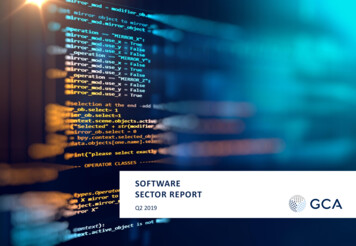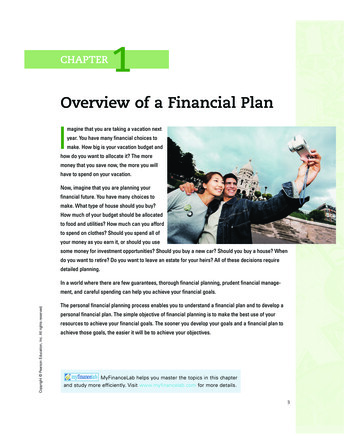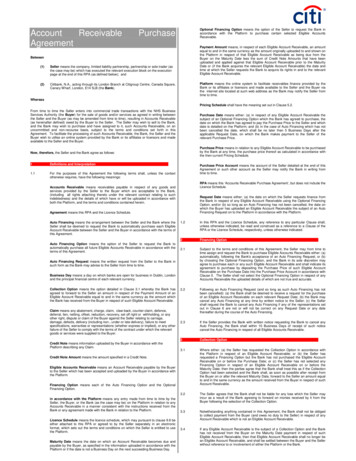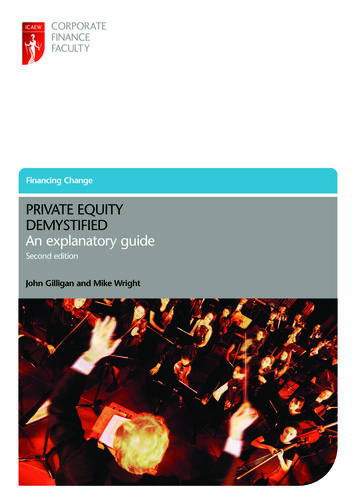
Transcription
Financing ChangePRIVATE EQUITYDEMYSTIFIEDAn explanatory guideSecond editionJohn Gilligan and Mike Wright
Financing ChangeAn initiative from the ICAEW Corporate Finance FacultyThe first edition of Private Equity Demystified – An Explanatory Guide was published inAugust 2008, as the first report to be issued under Financing Change, the thoughtleadership programme of the ICAEW Corporate Finance Faculty. The faculty is the world’slargest network of professionals involved in corporate finance and counts accountants,lawyers, bankers, other practitioners and people in business among its members.Financing Change aims to advance the economic and social contribution of corporatefinance activity by promoting better understanding and practice.Since the publication of the first edition of Private Equity Demystified the major economieshave moved from growth to recession, the global banking community has experiencedunprecedented turmoil and distress and we have all come to be familiar with the term‘credit crunch’.We have also seen the publication, in April 2009, of the European Commission’sproposed Alternative Investment Fund Managers directive which would cover privateequity funds.The second edition builds on the work of the first edition to reflect this recent turmoiland examines the way in which the banking market has changed its approach to privateequity investments. It also includes more discussion of both mid-market buy-outs and thedynamics of the restructuring industry.It remains the case that media coverage of private equity and some public commentaryhave frequently displayed a poor understanding of how private equity operates, yet thesesources are frequently relied upon as fact. This guide provides an objective explanation ofprivate equity, recognising that for public scrutiny to be effective it must be conductedon an informed basis.This publication is unlikely to result in a reduction in the scrutiny of private equity.Its value will be measured in better-informed debate, in private equity’s effectiveengagement with wider stakeholders and in well thought out public policies.We welcome views and other comments on this work and related themes.For further information on the Financing Change programme please emailfinancingchange@icaew.com or telephone 44 (0)20 7920 8685.For information on the ICAEW’s work in funding academic research please contactGillian Knight, Research Manager on 44 (0)20 7920 8478.The report, which includes a summary of academic studies and references, is alsoavailable to download from www.icaew.com/corpfinfac.March 2010 John Gilligan and Mike Wright 2010All rights reserved.Dissemination of the contents of this report is encouraged. Please give fullacknowledgement of the source when reproducing extracts in other published works.No responsibility for any person acting or refraining to act as a result of any material inthis document can be accepted by the authors or the ICAEW.ISBN 978-1-84152-830-4
PRIVATE EQUITYDEMYSTIFIEDAn explanatory guideSecond editionJohn Gilligan and Mike Wright
ContentsPagePreface to the second editionAcknowledgementsviviiiAbout the authorsixList of figures, tables and findingsxExecutive Summary11.2The private equity market151.1 An introduction to the private equity market161.2 What is private equity?161.3 A brief history of private equity in the UK161.4 How big is the private equity market?181.5 How significant are larger deals in the private equity market?201.6 What have been the biggest UK deals?211.7 What have been the biggest deals in the world?221.8 What are the largest private equity funds in the world?221.9 How significant are public to private transactions in the private equity market?231.10 What is the rationale for a public to private transaction?231.11 To what extent do private equity deals involve buy-outs of distressed firms?24Who are the participants in a private equity transaction?272.1 Introduction282.1.1Who’s who?2.2 The private equity fund28292.2.1What is a private equity fund?292.2.2How are private equity funds structured?292.2.3What do private equity fund managers do?302.2.4How does a private equity fund differ from a quoted equity fund?312.2.5How does a private equity fund differ from a group of companies?322.2.6What are hedge funds and how do they differ from private equity funds?332.2.7Emerging and converging alternative asset investors352.2.8Where do private equity fund managers operate?362.2.9Why are European private equity funds based predominantly in the UK?372.2.10 How are UK private equity fund managers rewarded?392.2.11 Management/advisory fee392.2.12 Carried interest402.2.13 Other fees402.2.14 Broad principles of UK fund taxation402.2.15 Taxation of carried interest412.2.16 What was taper relief and how did it affect the incentives ofprivate equity fund managers?412.2.17 Non-UK domiciled persons422.2.18 Competition for funds by private equity managers422.2.19 Can a private equity fund or a private equity manager fail?432.3 Investors in private equity funds452.3.1Who are the investors in private equity funds?452.3.2Are institutions long-term investors in private equity funds?462.3.3What are the average returns of the private equity market for investors?472.3.4Why do private equity funds value unrealised investments?482.3.5How do private equity funds value unrealised investments?482.3.6Understanding private equity portfolio valuation movements502.3.7Valuation of limited partner holdings: the J curve502.3.8What is the range of returns for investors?522.3.9How can individual investors invest in private equity funds?53Contents iii
2.4 Banks2.4.12.4.22.4.32.4.42.4.52.4.62.4.72.4.83What role do banks play in private equity?What is leveraged lending?How did the banking market change?Why did the banking market change?What are the risks of leveraged lending?What are collateralised debt obligations, collateralised loan obligationsand structured investment vehicles?What went wrong?How much leveraged lending have banks undertaken?5454545455555657582.5 Advisers and other service providers2.5.1 Who are the advisers and service providers in the private equity market?58582.6 Employees and other stakeholders2.6.1 What is the impact of private equity transaction on wider stakeholders?2.6.2 What is TUPE and when is it applied?6060602.7 Taxation2.7.1 The wider impact of leverage on UK tax revenues62622.8 Refinancing and exits2.8.1 Types of exit2.8.2 What has been the pattern of exits from private equity deals?2.8.3 Secondary buy-outs636364652.8.4 Leveraged recapitalisation2.9 How did the private equity industry respond to the public interest shown in it?2.9.1 What are the Walker Guidelines?2.9.2 Which companies do they apply to?2.9.3 How many companies and investors are covered by the guidelines?2.9.4 What do portfolio companies have to do to comply with the guidelines?2.9.5 What do private equity investors have to do to comply with the guidelines?66686868686969Evaluating, structuring and restructuring a private equity investment3.1 Value and pricing3.1.1 What is ‘value’? The difference between enterprise value and equity value3.1.2 What is ‘financial engineering’?3.1.3 How do you design and built financial instruments?3.1.4 What is a ‘Newco’?3.1.5 How do you decide whether to buy shares or assets?3.1.6 Pricing a transaction3.1.7 A financeable offer7172727374757676773.2 Senior debt and 2.17iv ContentsWhat is debt?What is senior debt, junior debt and subordinated debt?How much debt?How much debt? Cash flow lendingHow much debt? Security and cost of fundsHow did banks increase the levels of borrowings in buy-outs?Capital holidays and bullet loansHow did banks increase the levels of borrowings in buy-outs?Payment in kind debtWhy did banks increase the amount of debt?What is mezzanine?Can Newco repay the borrowings?What security will the banks have?What are the potential sources of cash flow to repay borrowings?Increasing post-tax profitsReducing working capitalFixed assets: to own or lease?What are proco/opco structures? A special caseAsset stripping and financial assistance7777777778798081828383838384848486
878888888888883.3 Institutional and management equity3.3.1 How much institutional equity?3.3.2 Internal rates of return and short termism3.3.3 Debt: equity ratio3.3.4 Are the largest leveraged buy-outs failing during the recession?3.3.5 How much equity do management get in a buy-out?3.3.6 What is a ratchet?909090929393943.4 Distress and restructuring3.4.1 What are the types of company distress?3.4.2 What are the early signs of financial distress?3.4.3 What is equity cure?3.4.4 What is financial restructuring?3.4.5 When is financial restructuring possible?3.4.6 What is a ‘hair cut’ and who bears 3.4.133.4.143.4.153.4.163.4.174What protection exists for publicly quoted companies?The risks of leverage: financial covenants and events of defaultIncurrence covenants and maintenance covenantsOne-to-one cash cover covenantNet assets covenantInterest cover covenantAn event of default and corporate failureHow can the risks of leverage be mitigated?What powers does a securred lender have?What tools are available to restructure a balance sheet?What are the differences in restructuring publicly traded debt?The paradox of syndicationWhy is there a growing use of distressed debt funds?What are credit default swaps? A perverse new set of incentivesEquity investors: the impact of distressEquity investors: what are the options?Change the companyChange the finance structureWhat is the position of management in a restructuring?What is good leaver/bad leaver?9798999999100100100100100102A detailed worked example of a leveraged buy-out and a restructuring4.1 Case study: illustrative operating projections4.1.1 Operating profit projections4.1.2 Cash flow projections4.1.3 A profit bridge1031041041051064.2 Funding requirement4.2.1 What are the transaction fees and expenses for?4.2.2 What are contingent fee arrangements?1071071084.3 Funding structure1084.4 The impact of leverage on profits and cash4.4.1 Restructured balance sheet4.4.2 PIK loan stock. What is ‘equity illusion’?1101141154.5 Taxation: how much tax is paid by a private equity-backed company?1164.6 Summary of corporation tax impact4.6.1 Due diligence4.6.2 What is vendor due diligence and how does it impact risks/rewards?1181191194.7 Sensitivity analysis1194.8 Exits and returns1204.9 Closing remarks123Appendix: Summaries of studies of buy-outs and private equityReferencesGlossary125138145Contents v
Preface to the second editionIn 2007 the private equity industry came under intense public scrutiny including a Houseof Commons Select Committee enquiry. We published the first edition of Private EquityDemystified in August 2008 and since then the financial world has experiencedunprecedented turmoil. We have therefore taken the opportunity to revisit the accusationslaid at the feet of the private equity industry and our tentative support for the industryin the first edition of this guide with the benefit of hindsight. In summary we find thethesis that private equity created, spread or encouraged an increase in systemic risk tobe almost wholly incorrect.We argue that in contrast to the forecasts of the critics, private equity has acted to containrisk, not disseminate it; has created alignment between managers and shareholders, nota misaligned bonus culture; and provides important models for corporate governanceand risk management that have a wider applicability.Private equity has frequently and erroneously been likened to the activities of hedge fundsand other so-called ‘shadow banking system’ members by many commentators andregulators. We drew attention to the differences between hedge funds, private equity fundsand other fund types at length in the first edition and reiterate them here. We continueto encourage regulatory bodies to be mindful of the clear distinction between theseinvestment forms and encourage all commentators to emphasise this distinction to aidpublic understanding and debate.The idea of aligning interests lies at the heart of the rationale for the business model ofthe private equity industry. Where that alignment breaks down, for example as it appearsto have done in the syndicated debt market, the problems associated with excessiveleverage follow closely behind.The corporate governance regime of public companies has been widely criticised forhaving weak non-executives, shareholders who sell shares rather than actively holdingmanagement to account and bonus-based reward systems that have no penalties forfailure. The structures seen in private equity transactions often directly address each ofthese issues.The belief in the enduring outperformance of the top fund managers is widely held andhas some historical support in independent academic research. Given the excesses ofthe past few years, it seems likely that this assumption may be challenged in the future.However, it is unclear how the market will be able to adjust in the short term if therelationship breaks down.The body of academic evidence is growing rapidly, but the quality of much researchis hampered by poor data availability, for both quantitative and qualitative research.Two broad approaches have been adopted. In the first, large data sets are subjectedto econometric analysis. These studies seek to identify significant differences betweenpopulations of buyouts and non-buy-out companies. In the second approach, small scaleand detailed case studies are used to examine the themes within the academic literature.These studies are often reliant on the provision of data by private equity funds themselvesand therefore are often viewed with suspicion by critics of the industry.The academic work to date is broadly supportive of the idea of alignment that lies at theheart of the private equity investment thesis. Recent evidence particularly suggests thatperformance improvements are most marked in buyouts of divisions.Overall we have found the following core strands in the analysis:1. Alignment: private equity uses financial engineering to create exaggerated incentivesand disincentives to achieve performance gains in corporations.2. Long term: private equity funds are generally different in structure to other fund typesprimarily because they are long term and illiquid for the investors and have lowbankruptcy risk.vi Preface
3. Low systemic risk: as a result of this difference in fund structure, private equity fundsdid not contribute to the credit crunch directly and do not directly create systemicrisk in financial markets.4. Early adopters: private equity rarely creates new financial technologies but is an earlyadopter of financial innovation. Some of these financial innovations were implicatedin the credit crunch and have changed the dynamics of the market both pre- andpost-investment.5. Banking failure: banks used new innovations to change their business models andas a result incentives were changed in a way that facilitated their failure. This wassymptomatic of banking generally, not of private equity.6. Alternative asset managers: the larger private equity funds are becoming multi-fundmanagers having more than long-term private equity funds under management. Thismodel may corrupt the original private equity model based on the idea of alignmentat all levels.7. Equity illusion: management teams need to be wary of the equity illusion and focuson their cash returns not their notional equity percentage.8. Corporate governance: the model of corporate governance used in private equityis materially different to that in public companies. The rewards for success are great,the penalty for under-performance clear. Shareholders are highly active in monitoringeach investment. It can be credibly argued that the private equity governance modeladdresses many of the issues that have been implicated in the failures of publicmarket accountability.9. Distress: in distressed situations banks have the strongest hand but can only achievea turnaround in conjunction with the ongoing management of the business.Leverage does increase the likelihood of distress, but not of failure.10. Syndication paradox: wide syndication of debt has resulted in a potential paradox:Syndication is designed to mitigate risk, but once that risk crystallises the fact thatdebt is widely held makes restructuring more costly and problematic, which increasesthe risks to both the lenders and borrowers.11. Evidence: there is an extensive, but as yet incomplete, body of peer-reviewed academicresearch regarding the impact of private equity. This research is broadly supportiveof the hypothesis that private equity has, in aggregate, a positive influence on theeconomy by facilitating and accelerating restructuring, with all the pain that that maycause at an individual level.12. Outstanding questions: the high levels of borrowing seen in the past decade mayresult in an increase in failures in buyouts. The number of funds in existence mayreduce as some fail.John GilliganMike WrightMarch 2010Preface vii
AcknowledgementsThis report has benefited immeasurably from the support and positive criticism of anumber of people, including anonymous reviewers and colleagues within both PKF andThe Centre for Management Buy-out Research at Nottingham University. Chris Ward,Deloitte, Chairman of the Corporate Finance Faculty from 2004 to 2008, not only sawthe need for a report, but has tirelessly reviewed many drafts with an eye for both detailand the big picture second to none, giving far more of his time than we could haveexpected and he could have anticipated when we first started. Richard Green, AugustEquity; Barry Lawson, Bridgepoint Capital and Jon Penfold and Terry Awan, Deloittesimilarly gave of their valuable time and, in the absence of any tangible reward, weoffer them our thanks. Without Robert Hodgkinson and especially Katerina Joannouof the ICAEW the report would never have seen the light of day. Thanks also to DebbieHomersham, Philip Chamberlain, Caroline Kearns and Richard Anning of the ICAEWand Nick Toyas of NT&A. All errors and omissions are entirely our own responsibility.viii Acknowledgements
About the authorsJohn Gilligan is a Corporate Finance Partner in PKF (UK) LLP. He has worked in theprivate equity and venture capital industry for over 20 years. He started his career in 1988at 3i Group plc as a financial analyst. He joined what is now Deloitte in 1993 and was apartner from 1998 to 2003. He is a Special Lecturer at Nottingham University BusinessSchool and has also taught at Cranfield University Business School.He has a degree in economics from Southampton University and an MBA in financialstudies from Nottingham University.Professor Mike Wright has been Professor of Financial Studies at Nottingham UniversityBusiness School since 1989 and Director of The Centre for Management Buy-outResearch since 1986. He has written over 25 books and more than 300 papers inacademic and professional journals on management buy-outs, venture capital, habitualentrepreneurs, corporate governance and related topics.He served two terms as an editor of Entrepreneurship Theory and Practice (1994–99) andis currently a joint editor of the Journal of Management Studies. He holds a BA (CNAA),MA (Durham), PhD (Nottingham) and an honorary doctorate from the University ofGhent and is the winner of the Academy of Management Entrepreneurship DivisionMentor Award 2009.Contact detailsJohn GilliganPartnerPKF (UK) LLPFarringdon Place20 Farringdon RoadLondon EC1M 3APUKTel: 44 (0)20 7065 0241Email: John.Gilligan@uk.pkf.comMike WrightCentre for Management Buy-out ResearchNottingham University Business SchoolJubilee CampusNottingham NG8 1BBUKEmail: mike.wright@nottingham.ac.ukandRotterdam School of ManagementErasmus University RotterdamBurgemeester Oudlaan 503062 PA RotterdamPO Box 1738300 DR RotterdamThe NetherlandsTel: 44 (0)115 951 5257About the authors ix
List of figures, tables and findings1. The private equity marketFigure 1.1:European private equity: new fund commitments, new investment18Figure 1.2:Number and value of UK private equity-backed buy-outs greater than 10m18Figure 1.3:Private equity-backed buy-outs above 10m as a percentage of UK takeover activity 19Figure 1.4:Average value of UK private equity-backed buy-outs ( m), above 10m19Figure 1.5:Buy-outs over 100m share of UK market value by value (%)20Figure 1.6:Buy-outs over 100m share of UK market by number of transactions (%)20Figure 1.7:UK public to private buy-outs: number and value23Figure 1.8:Buy-outs in receivership: number and value25Table 1.1:Major UK private equity houses and their predecessor firms17Table 1.2:Largest UK buy-outs21Table 1.3:The world’s largest buy-out bids22Table 1.4:Estimate of the world’s 25 largest private equity funds (by capital committed) 2007 22Findings 1.1: Does corporate governance in public to private deals differ from other listedcorporations before buy-out? The academic evidence242. Who are the participants in a private equity transaction?Figure 2.1:Participants in a leveraged buy-out28Figure 2.2:Structure of a typical private equity fund29Figure 2.3:Global private equity investment bn 200736Figure 2.4:Global private equity funds raised bn 200736Figure 2.5:Funds raised by country of fund manager 2007 (exc US)37Figure 2.6:Investment bn by country 2007 (exc US)37Figure 2.7:Evolution of EVCA/KPMG index of British tax and legal environmentfor private equity 2003–200839Figure 2.8:Illustrative relationship between fund size and fee income39Figure 2.9:Changing CGT rate to higher rate taxpayers on business assets 1998–200842Figure 2.10: Full members of the BVCA 1985–200744Figure 2.11: BVCA members joining/leaving the BVCA by year: 1985–200744Figure 2.12: Investors in private equity/VC funds by type of investor 2002–200645Figure 2.13: Geographic origin and country of management of European funds raised in 2006 46Figure 2.14: Return to mid-large buy-outs: distributed versus unrealised value47Figure 2.15: Valuation decision tree48Figure 2.16: The J curve: cumulative cash flow and total return after fees and beforecarried interest51Figure 2.17: Realised and unrealised value per 1.00 invested51Figure 2.18: Distribution of returns to mid-large buy-outs funds: total value per invested52Figure 2.19: Distribution of returns to mid-large buy-out funds: cash distributed per invested 52Figure 2.20: Schematic of CDO/CLO/SIV56Figure 2.21: Flow of risks from original lenders through securisation to bond markets57Figure 2.22: Illustrative advisers to a transaction59Figure 2.23: Taxation general schematic62Figure 2.24: Divestment proceeds by type of exit63Figure 2.25: Write offs by value and % of total divestments (excluding loan andpreference repayments)64Figure 2.26: UK exit numbers by type of exit64Figure 2.27: Secondary buy-outs by number and value65Figure 2.28: Average time to exit: private equity-backed buy-outs over 10m by year of exitin the UK6731Table 2.1:Key differences between private equity and quoted equity fundsTable 2.2:Key differences between private equity and trading groups of companies32Table 2.3:Key differences between private equity and hedge funds33Table 2.4:Selected other activities of the world’s largest private equity investors (as at 2008) 35Table 2.5:Reconciliation of BVCA membership from 1985–2008x List of figures, tables and findings43
Table 2.6:Top 20 fund of funds in recent global private equity 200745Table 2.7:Pooled returns in larger buy-outs 1996–200647Table 2.8:Investee company compliance to the Walker Guidelines68Table 2.9:Private equity firm compliance with the Walker Guidelines68Findings 2.1: Do investors earn superior returns? The academic evidence53Findings 2.2: Do private equity and buy-outs adversely affect employment?The academic evidenceFindings 2.3: Do private equity and buy-outs adversely affect wages? The academic evidence6161Findings 2.4: What is the impact of private equity on human resources management?The academic evidence62Findings 2.5: What are the effects of private equity on debt holders? The academic evidence63Findings 2.6: What are the effects of private equity on taxation? The academic evidence63Findings 2.7: Do private equity deals involve the short-term ‘flipping’ of assets?The academic evidence66Findings 2.8: What is the extent of asset sales and refinancing? The academic evidence67Findings 2.9: Do the effects of private equity continue after exit? The academic evidence673. Evaluating, structuring and restructuring a private equity investmentFigure 3.1:Equity value, enterprise value and asset value72Figure 3.2:Types of financial instrument: risk and reward73Figure 3.3:The basic building blocks of financial engineering74Figure 3.4:Outline structure of a leveraged buy-out75Figure 3.5:Relationship between length of loan, interest rate and multiple of free cash flow(in an equal payment fully amortising loan)78Figure 3.6:Illustrative security value of a failing company’s assets78Figure 3.7:Impact of capital holidays of various lengths on the cash requirement of loans(seven-year loan)79Figure 3.8:Margins on tranches of senior debt (basis points above LIBOR)81Figure 3.9:Illustration of the restructuring into a propco/opco structure84Figure 3.10: Schematic illustrating banking covenants87Figure 3.11: Percentage of UK buy-outs ending in receivership: by value rangeand vintage year89Figure 3.12: IRR versus time of exit at various exit multiples91Figure 3.13: The limits of the most common restructuring options98Table 3.1:Calculation of enterprise value and equity value72Table 3.2:Creating a hierarchy of financial instruments by varying risk and reward75Table 3.3:Stylised comparison of security in a retailer and a manufacturer79Table 3.4:IRRs calculated at varying exit years and varying exit multiples oforiginal investment90Table 3.5:Multiple of money calculated at varying years of exit and IRRs91Table 3.6:Impact of varying yields on the capital gain required to generate an IRR of 25%92Table 3.7:Largest private equity-backed receiverships93Findings 3.1: Does higher leverage lead to increased likelihood of failure?The academic evidenceFindings 3.2: Where do buy-outs get the cash to pay down the debt? The academic evidence8285Findings 3.3: To what extent to do private equity deals involve strategies to grow the business?The academic evidence86Findings 3.4: Do private equity deals and buy-outs have adverse effects on investment andR&D? The academic evidence86Findings 3.5: What proportion of buy-outs fail? Industry data89Findings 3.6: What do secured creditors recover? The academic evidence90Findings 3.7: Has the debt-equity ratio been increasing in private equity deals? The evidence93Findings 3.8: To what extent are managerial equity, leverage and private equity boardinvolvement responsible for performance changes? The academic evidence94List of figures, tables and findings xi
4. A detailed worked example of a leveraged buy-outFigure 4.1:Actual and forecast sales and profit104Figure 4.2:EBITDA and operating cash flows105Figure 4.3:EBIT: profit bridge107Figure 4.4:Sources of funding109Figure 4.5:The funding package analysed by funding requirement, security available,source of funds, detailed financial insturment and type of financial instrument109Figure 4.6:Profit: EBITA, EBIT, NPBT110Figure 4.7:Difference between interest accrued and interest paid112Figure 4.8:Cash flows: before and after finance costs112Figure 4.9:Forecast values of interest cover and cash cover113Figure 4.10: Forecast security cover114Figure 4.11: Taxable profit and accounting profit are different116Figure 4.12: The book value of assets is different to the tax written down valuebecause of capital allowances117Figure 4.13: Calculation of goodwill118Table 4.1:Operating profit projections104Table 4.2:Actual and forecast operating cash flows105Table 4.3:Profit bridges106Table 4.4:Funding requirement107Table 4.5:Sources of funding108Table 4.6:Illustrative financing structure110Table 4.7:Summary of projected consolidated profit and loss account after funding111Table 4.8:Reconciliation of interest charges112Table 4.9:Summary of cash flows after funding113Table 4.10:Summary of projected consolidated balance sheets114Table 4.11:Alternative balance sheet presentation115Table 4.12:PIK debt and the equity illusion115Table 4.13:Restatement of profit for tax purposes in a typical company116Table 4.14:Calculation of goodwill117Table 4.15:Enterprise value and equity value at exit120Table 4.16:Allocation of net equity value121Table 4.17:Projected share of exit enterprise value by investor121Table 4.18:Reconciliation of the relative effects of operating performance and financialengineering on equity value at exit in years 2 and 3121Table 4.19:Split of proceeds on exit122Table 4.20:Projected returns (IRRs) by participant (exit year 3, PE 12)122Table 4.21:Private equity investor blended returns: sensitised by year of exit and exit P/E ratio 122xii List of figures, tables and findings
Executive SummaryObjective of the reportThis is the second edition of Private Equity Demystified – An Explanatory Guide. In the firstedition we sought to contribute to a debate about the private equity industry by clarifyinghow the industry works. We provided a summary of the findings of a review of approximately100 peer-reviewed academic papers which have examined aspects of the private equityindustry over the past 25 years. This was the most comprehensive review of academicresearch in this area ever undertaken.Since we wrote the first edition, there has been unprecedented market turmoil and financialdistress across the global banking system. The analysis in this second edition expands on someof our earlier discussion in the light of this t
The first edition of Private Equity Demystified -An Explanatory Guidewas published in August 2008, as the first report to be issued under Financing Change, the thought . 2.9.5 What do private equity investors have to do to comply with the guidelines? 69 3 Evaluating, structuring and restructuring a private equity investment 71 .
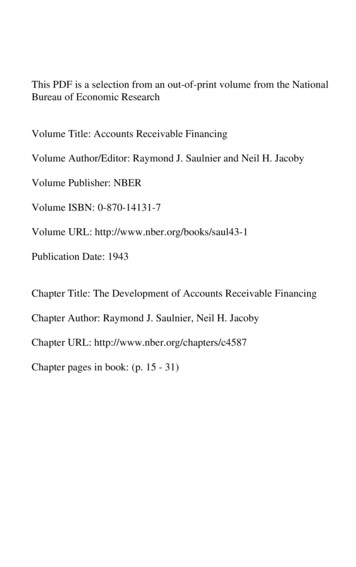

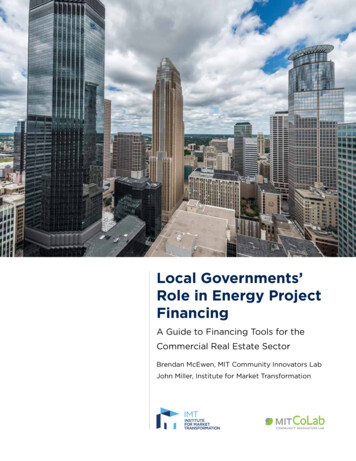

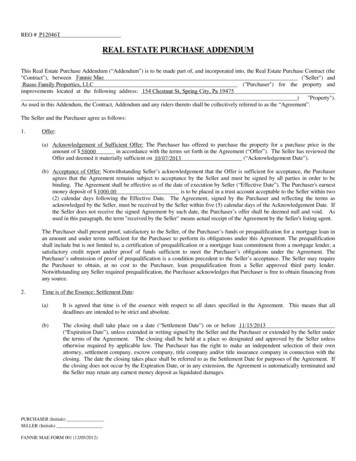
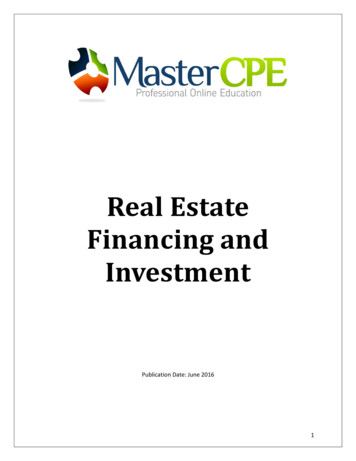
![Change Management Process For [Project Name] - West Virginia](/img/32/change-20management-20process-2003-2022-202012.jpg)
